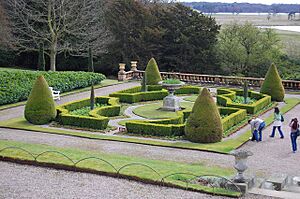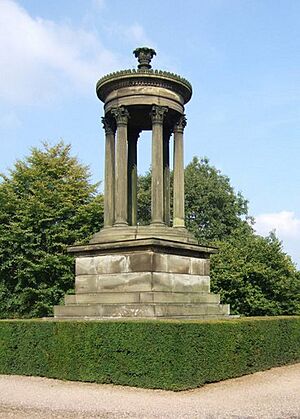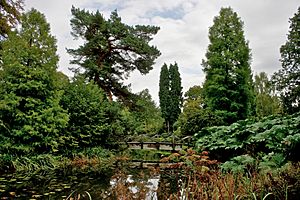Tatton Park Gardens facts for kids
Tatton Park Gardens are beautiful gardens located in Tatton Park, near Tatton Hall in Cheshire, England. These gardens include many different styles, such as an Italian garden, a walled garden, a rose garden, and a special Japanese garden. You can also find buildings like the Conservatory, the Fernery, and the Showhouse within the gardens. The National Trust owns these gardens, and Cheshire East Council helps manage them. They are recognized as important historic gardens in England and are open for everyone to visit at certain times.
Contents
A Look Back: How the Gardens Grew
The first gardens at Tatton Park were created around the early 1700s. They had a walled garden south of the house and a formal pond to the north. Later, in the 1700s, an arboretum (a collection of different trees) was started. By 1795, it already had several types of trees!
One of the first formal gardens for the current house was Charlotte's Garden, designed in 1814. The Conservatory, a building made of sandstone for growing plants, was also designed around this time. It was sometimes called the Orangery because oranges were grown there. In the 1830s, a copy of an ancient Greek monument was placed at the end of the Broad Walk, a wide path through the gardens.
The Italian Garden and Fernery
In 1847, the terraces south of the house were turned into an Italian Garden. This was designed by Joseph Paxton, a famous garden designer. Later, in 1883, stone railings were added. A statue of Neptune, the Roman god of the sea, was brought from Venice and added in 1920. This garden was carefully restored in 1986 to look like its original design.
In 1859, the Fernery was built to the west of the Conservatory. It was designed to house tree ferns from New Zealand. You might have even seen the Fernery on TV in the show Brideshead Revisited.
The Japanese Garden and Rose Garden
In 1910, after visiting a special exhibition in London, Alan de Tatton created the Japanese garden. This garden mixes Japanese and Western styles, making it a unique example of the Anglo-Japanese style. Many items in the garden, like the Shinto shrine, are thought to have come directly from Japan.
In 1913, Alan de Tatton also designed the Rose Garden for his wife. It even had a pool for bathing! Gardeners had to finish their work by 10 AM so Lady Egerton could enjoy the garden in peace. Later, Maurice Egerton built the African Hut, inspired by his trips to Africa. He also planted many azaleas and rhododendrons.
By the end of the 1900s, the Japanese Garden had become overgrown. It was beautifully restored in 2001. Since then, the kitchen garden has also been brought back to life.
Exploring the Gardens: What You'll See
When you enter the gardens today, you first arrive at the Walled Garden. On top of one wall, you'll see objects that look like urns, but they are actually chimney pots for a wall that used to be heated! Buildings like mushroom sheds, onion stores, and glasshouses have been restored. The vegetable garden grows plants that were common during the Edwardian era.
The Pleasure Gardens
From the Walled Garden, you enter the "Pleasure Gardens." These areas were made for enjoyment, not for growing food. Here, you'll find the L Borders, which have plants arranged in a formal style. South of these borders is Charlotte's Garden. This garden has a conservatory, an arbour, a fountain, a rockery, and a winding "snake path." All five of these original features are still there!
The L Border, the Broad Walk, and Beech Avenue form the main path leading south to the Monument. Across from Charlotte's Garden is the Topiary area, which leads to the Rose Garden. This garden has a Tea House and other items from a nearby estate called Rostherne Manor. South of the Rose Garden is the Tower Garden, which has a brick tower. This tower was originally used to watch for sheep thieves in the park!
Along the western side of the garden is the Arboretum. It has 880 plants from 281 different types of trees! Important trees here include a Giant Redwood, a Weymouth Pine, and a Mexican White Pine.
Special Gardens: Japanese and Italian
The Japanese Garden is considered one of the best Japanese gardens in the United Kingdom, and maybe even in Europe! It's a great example of the Anglo-Japanese style. Inside, you'll find a Shinto Shrine, a tea house, a bridge over the Golden Brook, and many lanterns. The garden uses plants, stones, and rocks placed carefully to create a natural and balanced look. Some stones are chosen for their unique shapes, and there's even a mound shaped like Mount Fuji with its snowy top! Plants like Japanese maple and various mosses add to its beauty.
East of the Broad Walk is Maurice Egerton's African Hut. North of this is the Maze, which is made from hornbeam and beech trees.
The Italian Garden is southeast of Tatton Hall. It's a formal garden with two levels. The main feature is the statue of Neptune. What's interesting is that you can see the pipes behind the statue! Near the house, you'll also find the Conservatory, the Fernery, and the Showhouse.
Tatton Park Gardens Today
The National Trust owns these gardens, and Cheshire East Council manages them. They are open to the public at specific times. The Fernery still has its amazing tree ferns, and the Showhouse features changing displays of beautiful flowering plants. You can even buy fresh produce from the Walled Garden at the garden shop! A team of volunteers helps keep the gardens looking wonderful. They also offer courses if you want to learn more about gardening.






